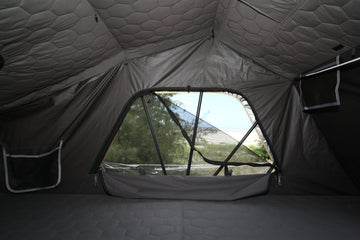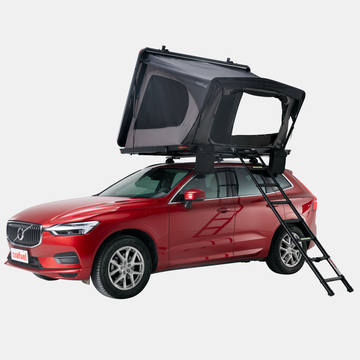
Fourth, Mattress: Generally, rooftop tents offer three main types of mattresses: high-density foam, memory foam, and inflatable mattresses. High-density foam provides a certain level of support and comfort and is known for its durability. Memory foam is a material that offers good compression and rebound properties, adapting to the body's shape and pressure points, providing personalized support and comfort.
Inflatable mattresses are a lightweight and easy-to-store option. They are usually made of PVC or TPU materials and provide a comfortable sleeping surface through inflation. The thickness of the mattress is typically between 1.2 and 2.8 inches, but a thinner mattress does not necessarily mean it lacks comfort; some thinner mattresses can still provide a good sleeping experience. It is also important to consider selecting a mattress with good moisture resistance and waterproof properties.
Rooftop tents are susceptible to moisture in the environment and unpredictable weather conditions, so ensuring the mattress can effectively resist moisture and remain dry and comfortable is crucial. Therefore, when choosing a mattress, consider your preferences and requirements to select the appropriate material.
Fifth, Zippers: The majority of tents on the market use YKK and SBS zipper brands, which provide good quality zippers. However, in terms of smoothness of use, YKK zippers offer a relatively better experience but are also more expensive than other brands. You can consider the quality of the product, the intended usage scenarios, and your personal budget to make the most suitable choice.
Sixth, Added Convenience: This includes features such as shoe bags, built-in pockets, and hooks. Different tents provide different types of shoe bags, which can be detachable or non-detachable, with or without mesh on the back. Shoe bags with mesh allow rainwater and mud to drain, keeping shoes dry. Built-in pockets and hooks may seem like small details, but they play a significant role in organizing and storing items when you use the tent.
Seventh, Ventilation: The importance of ventilation in a rooftop tent cannot be overlooked during camping. Good ventilation promotes airflow and helps reduce internal heat buildup in hot weather, providing a cooler interior. In cold weather, ventilation helps reduce moisture and condensation, creating a more comfortable sleeping environment.
Hard-shell tents can only have ventilation through three sides with doors and windows, which may be less ventilated compared to other tent styles. However, there are now tents available on the market that have a ventilation opening on one side of the hard shell, providing good ventilation as well. If ventilation is a priority for you, it is recommended to pay attention to the doors, windows, and ventilation openings when selecting a tent.
Eighth, Light Strips: Lighting inside the tent, especially during nighttime, is crucial. Most tents now offer light strips, but there are additional details to consider. Is the light strip detachable? A detachable light strip allows you to place it anywhere you want. Is the brightness adjustable? Adjustable lighting can meet your various lighting needs. Are there exposed components of the light strip that may affect its aesthetics?
Ninth, Fabric: Nowadays, most rooftop tents use rain-resistant fabrics, but there are differences in their waterproof ratings. Taking 210D Rip-stop Poly-oxford PU coated 3000mm as an example, 210D means the weight of 210 grams per 9000 meters of length, and a higher Denier value typically indicates a more robust and durable material. Rip-stop prevents fabric from tearing and spreading, providing better durability.
Poly-oxford is a synthetic fiber material with good strength and abrasion resistance. PU coated means the fabric has waterproof, moisture-resistant, and durable properties due to the polyurethane coating. The number 3000mm indicates the tent material's waterproof rating, and a higher value indicates better waterproofing. Additionally, the tent's design, sealing, and installation methods can also affect its waterproof performance. Therefore, when purchasing a rooftop tent, it is recommended to consider the waterproof ratingThank you very much for providing the information. The factors you mentioned, such as the weight of the rooftop tent, mattress, zippers, convenience features, ventilation, light strips, and fabric, are all important aspects to consider when choosing a rooftop tent. These factors will directly impact the performance and user experience of the tent.
Weight is a key indicator, especially for rooftop tents as it can affect the load capacity and driving performance of the vehicle. Soft-shell tents made of canvas or nylon are generally lightweight, but they may not be as durable as other tent styles. Hybrid tents that combine soft and hard shells offer enhanced durability but also increase the weight. Aluminum shell tents are the heaviest option but provide excellent strength and durability. Consider your weight requirements and the vehicle's capacity when selecting a rooftop tent.
The mattress options typically include high-density foam, memory foam, and inflatable mattresses. High-density foam provides support and durability, memory foam offers personalized comfort, and inflatable mattresses are lightweight and easy to store. Consider the thickness, moisture resistance, and waterproof properties of the mattress when making a choice.
Zippers are an important component of the tent, and brands like YKK and SBS are known for their quality. YKK zippers generally offer a smoother experience but are pricier. Consider the quality, usage scenarios, and budget when selecting zippers.
Added convenience features like shoe bags, built-in pockets, and hooks can enhance the usability of the tent. Shoe bags with mesh allow for drainage, built-in pockets help with organization, and hooks are useful for hanging items.
Ventilation is crucial for a comfortable camping experience. Good airflow reduces heat buildup in hot weather and minimizes condensation in cold weather. Pay attention to the doors, windows, and ventilation openings when selecting a tent.
Light strips inside the tent are important for nighttime illumination. Consider whether the light strip is detachable, if the brightness is adjustable, and if there are any exposed components that may affect aesthetics.
Fabric choice is essential for waterproofing. Look for rain-resistant fabrics with high Denier values, rip-stop properties, and a polyurethane (PU) coating for waterproof, moisture-resistant, and durable characteristics. The higher the waterproof rating, the better the performance. Additionally, consider the tent's design, sealing, and installation methods for overall waterproofing.
When purchasing a rooftop tent, it is recommended to consider these factors to ensure you choose a tent that meets your needs and provides a comfortable camping experience.





